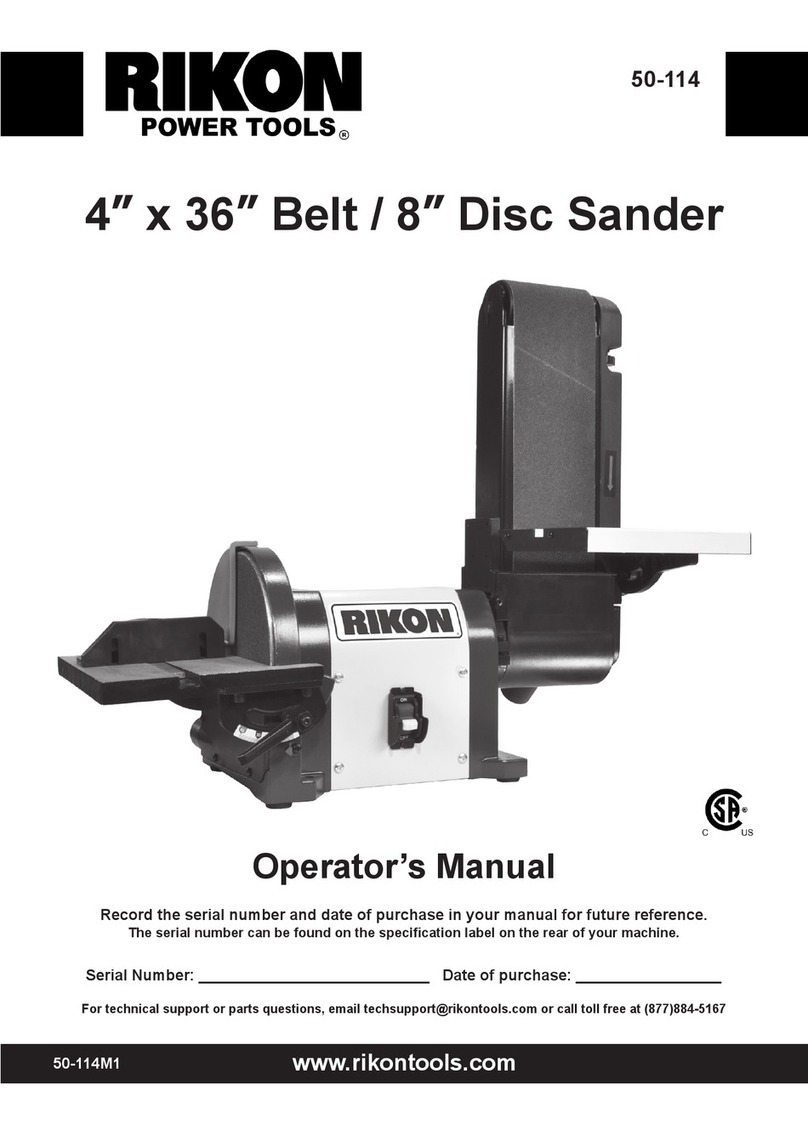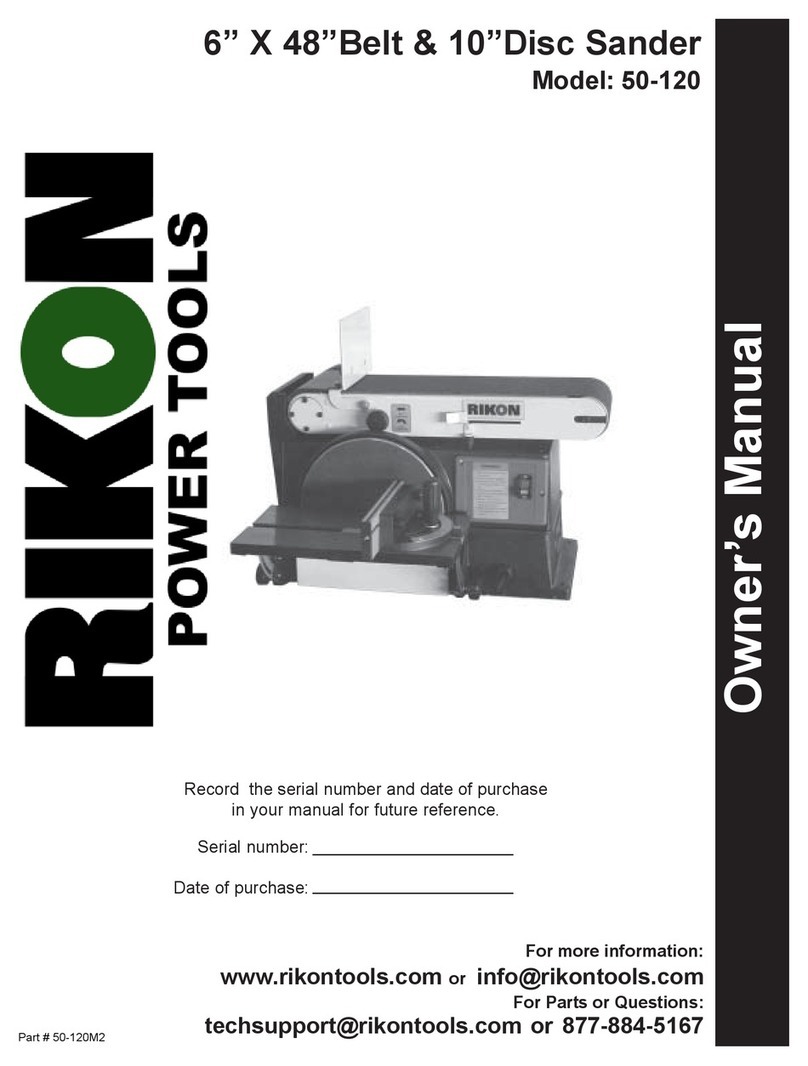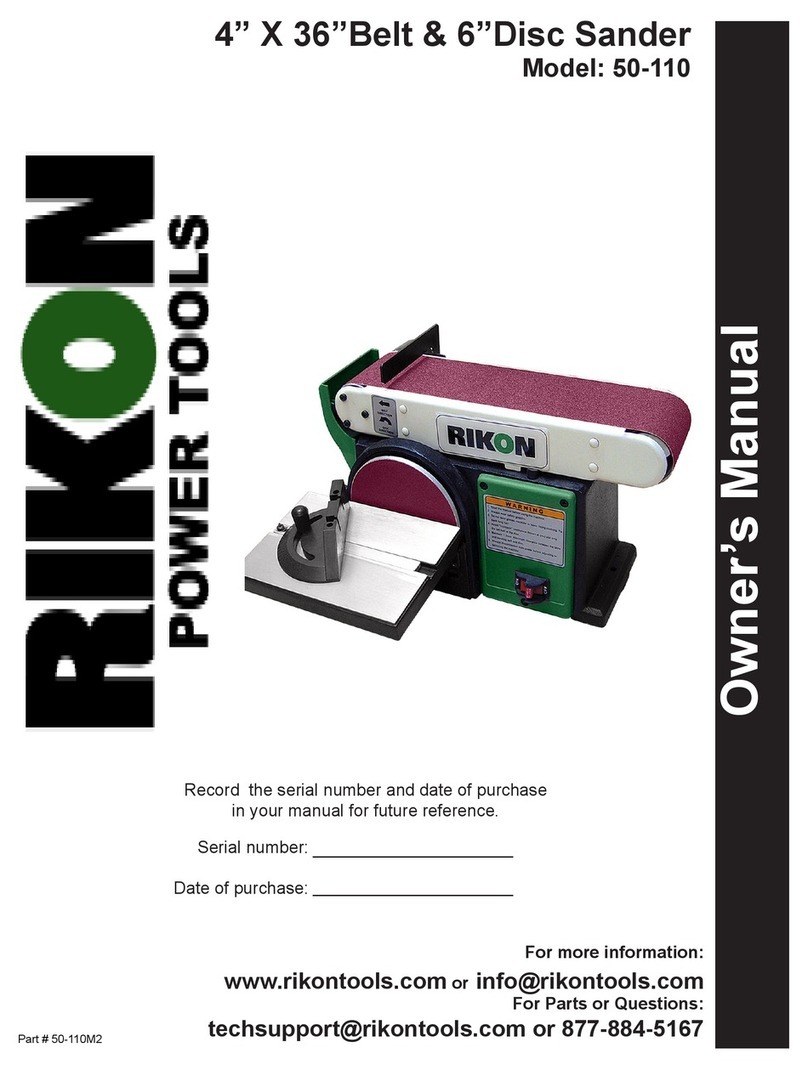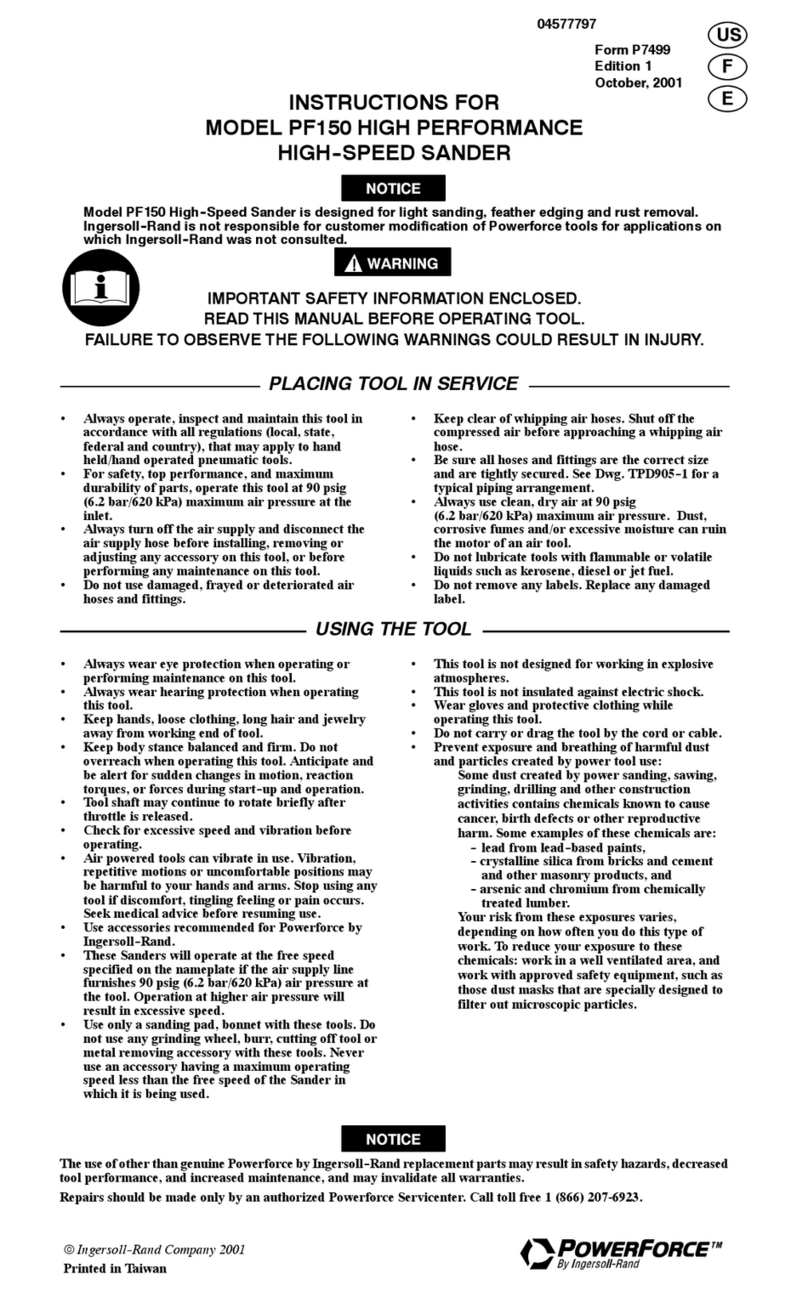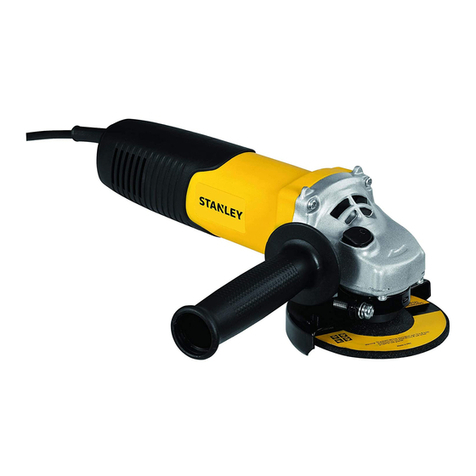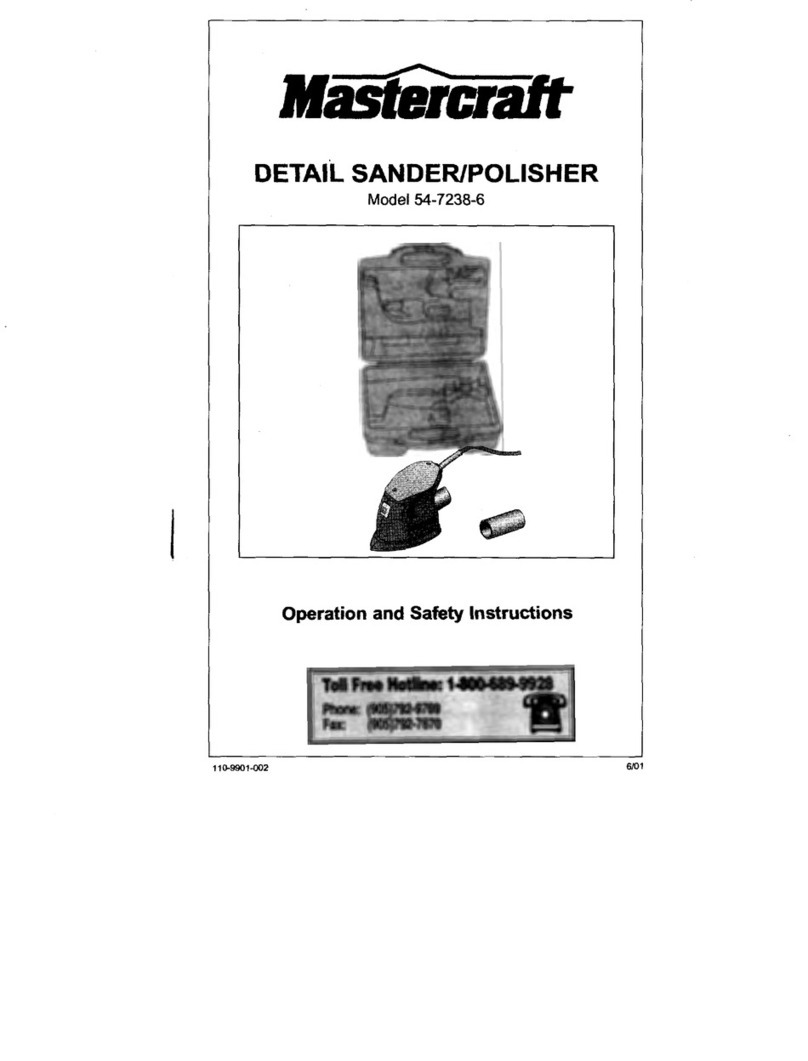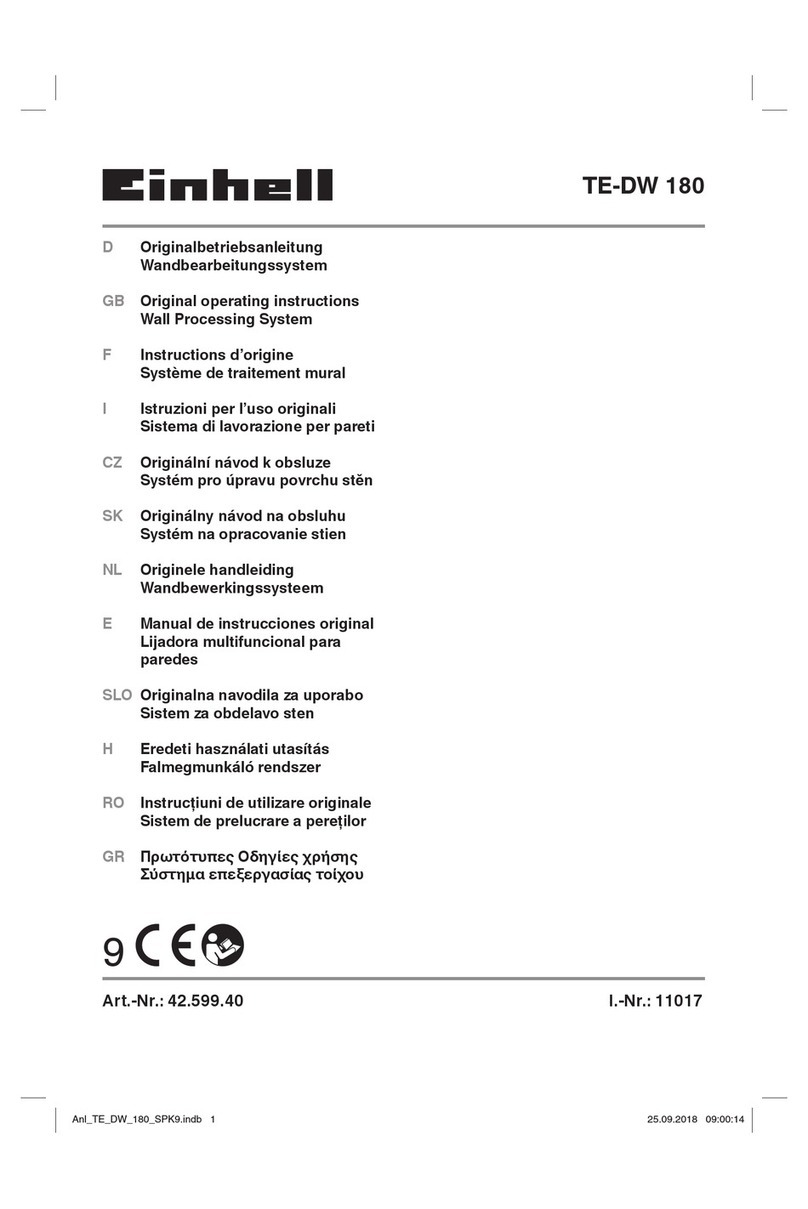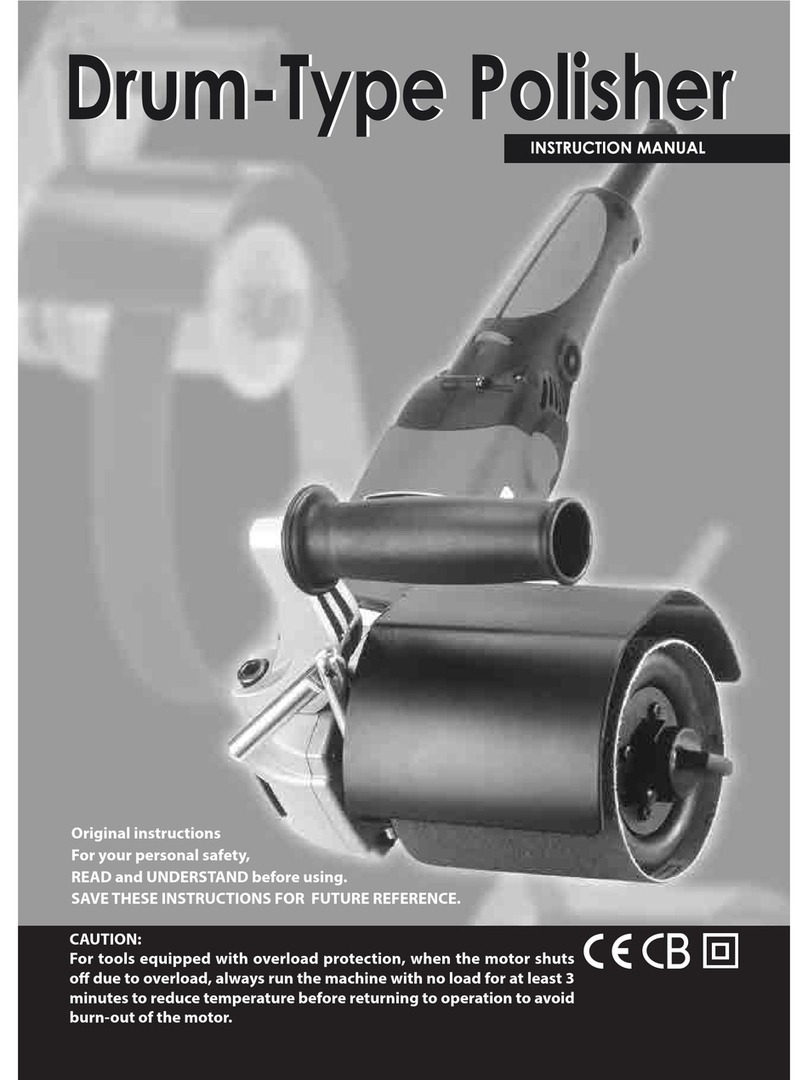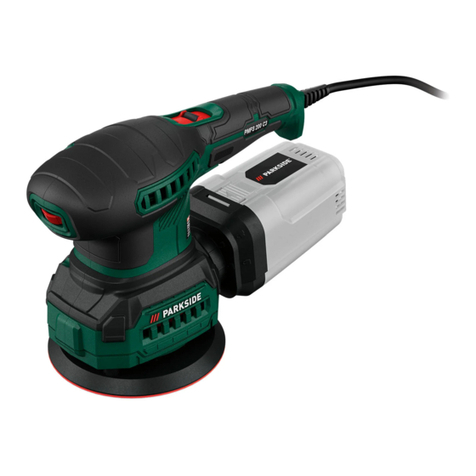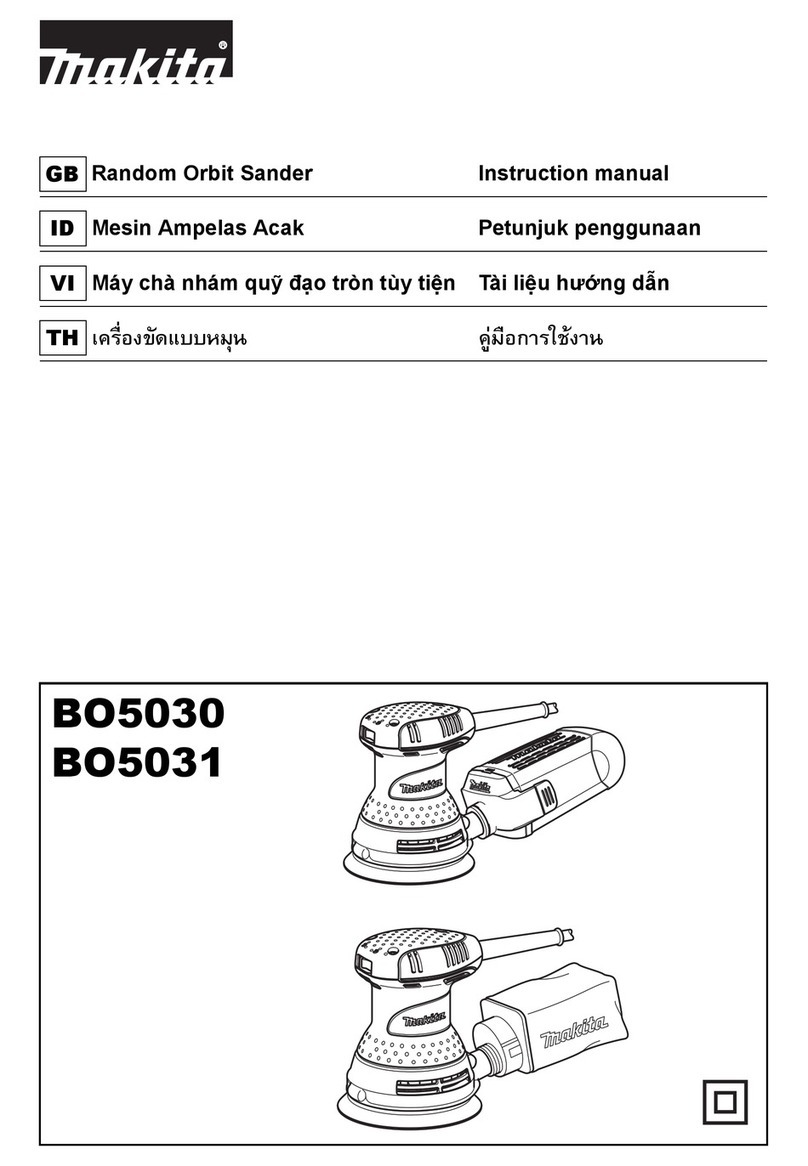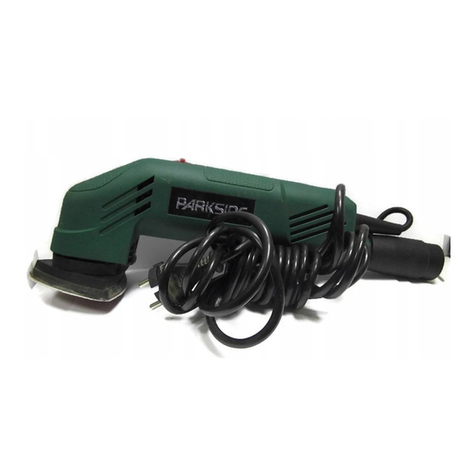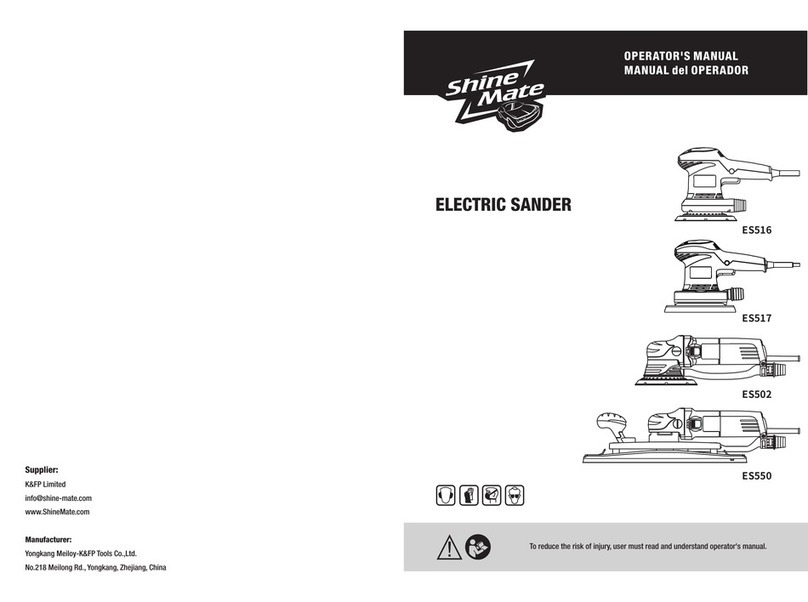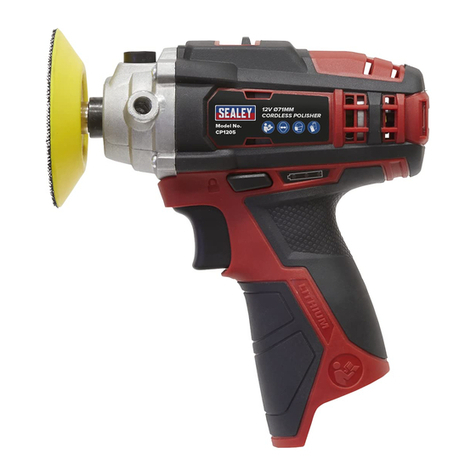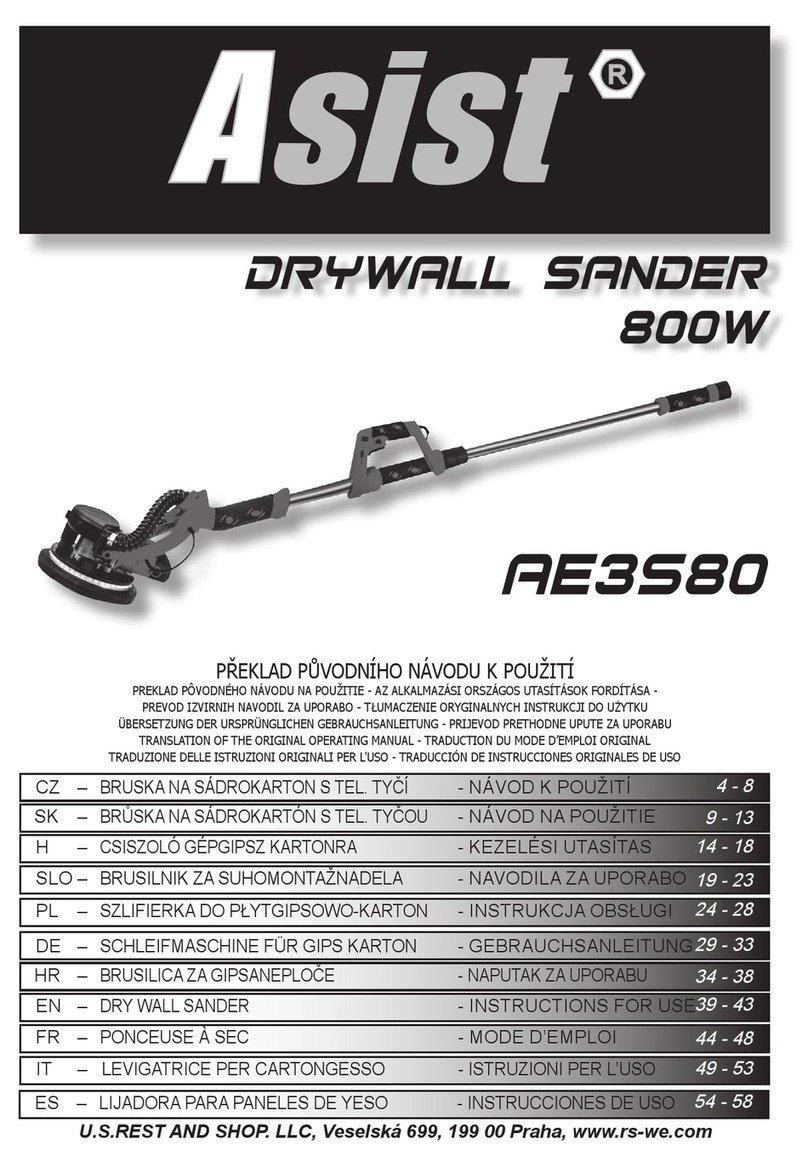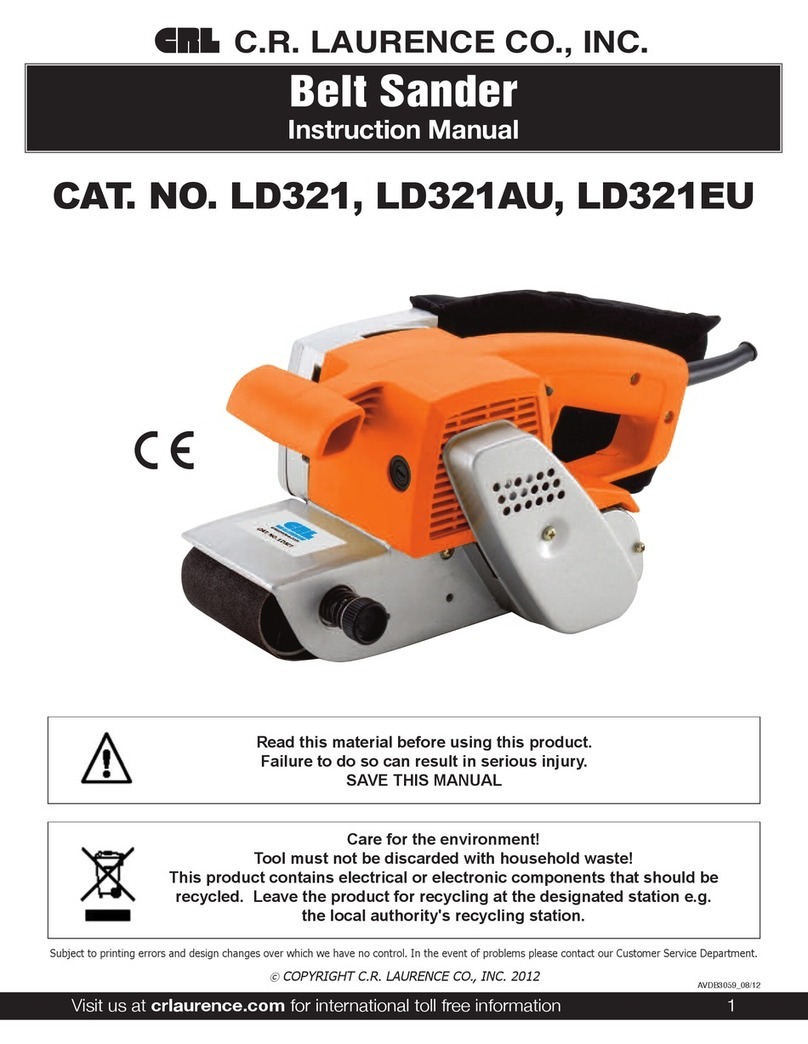Rikon Power Tools 51200 User manual

www.rikontools.com
51-200M3
Operator’s Manual
Record the serial number and date of purchase in your manual for future reference.
Serial Number: _________________________ Date of purchase: _________________________
For technical support or parts questions, email [email protected] or call toll free at (877)884-5167
12” Benchtop Disc Sander
51-200
4001824

Specications ........................................................................................................................................2
Safety Warnings.........................................................................................................................................3-6
Electrical Requirements ...............................................................................................................................5
Sander Safety Rules .................................................................................................................................6
Contents of Package .........................................................................................................................................7
Assembly/Adjustments.............................................................................................................8-9
Operation............................................................................................................9-10
Troubleshooting...............................................................................................................................................11
Parts Diagram...........................................................................................................................................12
Parts List .....................................................................................................................................13
Wiring Diagram......................................................................................................................................14
Accessories ........................................................................................................................14
Notes ..........................................................................................................14
Warranty .............................................................................................................................................15
2
TABLE OF CONTENTS
SPECIFICATIONS
NOTE: The specications, photographs, drawings and information in this manual represent the current model
when the manual was prepared. Changes and improvements may be made at any time, with no obligation on
the part of Rikon Power Tools, Inc. to modify previously delivered units. Reasonable care has been taken to
ensure that the information in this manual is correct, to provide you with the guidelines for the proper safety,
assembly and operation of this machine.
Motor .......................................................................................................................... 1/2 HP
Amps .....................................................................................................................................6
Volts .................................................................................................................... 120V, 60 Hz
Disc Diameter .............................................................................................................12” PSA
Speed ................................................................................................................... 1,720 RPM
Table Size (LxW) ............................................................................................ 17-1/8” x 6-1/2”
Table Tilt ......................................................................................................45° Up and Down
Miter Gauge ...............................................................................................................Included
Miter Gauge ‘T’ Slot ................................................................................................ 3/8” x 3/4”
Dust Outlet ....................................................................................... 2-1/4” I.D. or 2-1/2” O.D.
Height ................................................................................................................................ 16”
Width ................................................................................................................................. 19”
Depth ........................................................................................................................... 16-1/4”
Base Size (LxW) ................................................................................................. 12-5/8” x 11”
Net Weight .................................................................................................................. 62 Lbs.
Shipping Weight .......................................................................................................... 72 Lbs.
Shipping Carton ........................................................................................ 21” x 18” x 17-1/4”

3
SAFETY SYMBOLS
IMPORTANT! Safety is the single most important consideration in the operation of this equipment. The following
instructions must be followed at all times. Failure to follow all instructions listed below may result in electric shock,
re, and/or serious personal injury.
There are certain applications for which this tool was designed. We strongly recommend that this tool not be modied
and/or used for any other application other than that for which it was designed. If you have any questions about its
application, do not use the tool until you have contacted us and we have advised you.
SAFETY INSTRUCTIONS
GENERAL SAFETY
KNOW YOUR POWER TOOL. Read the owner’s manual
carefully. Learn the tool’s applications, work capabilities,
and its specic potential hazards.
BEFORE USING YOUR MACHINE
To avoid serious injury and damage to the tool, read and
follow all of the Safety and Operating Instructions before
operating the machine.
1. Some dust created by using power tools contains chem-
icals known to the State of California to cause cancer, birth
defects, or other reproductive harm.
Some examples of these chemicals are:
• Lead from lead-based paints.
• Crystalline silica from bricks, cement, and other
• masonry products.
• Arsenic and chromium from chemically treated lumber.
Your risk from these exposures varies, depending on how
often you do this type of work. To reduce your exposure to
these chemicals: work in a well ventilated area and work
with approved safety equipment, such as those dust masks
that are specially designed to lter out microscopic
particles.
2. READ the entire Owner’s Manual. LEARN how to use
the tool for its intended applications.
3. GROUND ALL TOOLS. If the tool is supplied with a 3
prong plug, it must be plugged into a 3-contact electrical
receptacle. The 3rd prong is used to ground the tool and
provide protection against accidental electric shock. DO
NOT remove the 3rd prong. See Grounding Instructions
on the following pages.
4. AVOID A DANGEROUS WORKING ENVIRONMENT.
DO NOT use electrical tools in a damp environment or
expose them to rain.
5. DO NOT use electrical tools in the presence of
ammable liquids or gasses.
6. ALWAYS keep the work area clean, well lit, and
organized. DO NOT work in an environment with oor
surfaces that are slippery from debris, grease, and wax.
7. KEEP VISITORS AND CHILDREN AWAY. DO NOT
permit people to be in the immediate work area,
especially when the electrical tool is operating.
8. DO NOT FORCE THE TOOL to perform an operation
for which it was not designed. It will do a safer and
higher quality job by only performing operations for
which the tool was intended.
9. WEAR PROPER CLOTHING. DO NOT wear loose
clothing, gloves, neckties, or jewelry. These items can
get caught in the machine during operations and pull the
operator into the moving parts. The user must wear a
protective cover on their hair, if the hair is long, to
prevent it from contacting any moving parts.
10. CHILDPROOF THE WORKSHOP AREA by
removing switch keys, unplugging tools from the
electrical receptacles, and using padlocks.
11. ALWAYS UNPLUG THE TOOL FROM THE
ELECTRICAL RECEPTACLE when making adjust-
ments, changing parts or performing any maintenance.
SAFETY ALERT SYMBOL: Indicates DANGER, WARNING, or CAUTION. This symbol may be used
in conjunction with other symbols or pictographs.
Indicates an imminently hazardous situation, which, if not avoided, could result in death or
serious injury.
Indicates a potentially hazardous situation, which, if not avoided, could result in death or serious
injury.
Indicates a potentially hazardous situation, which, if not avoided, could result in minor or
moderate injury.
NOTICE: Shown without Safety Alert Symbol indicates a situation that may result in property damage.

4
SAFETY INSTRUCTIONS
16. NEVER LEAVE A RUNNING TOOL UNATTENDED.
Turn the power switch to the “OFF” position. DO NOT
leave the tool until it has come to a complete stop.
17. DO NOT STAND ON A TOOL. Serious injury could
result if the tool tips over, or you accidentally contact the
tool.
18. DO NOT store anything above or near the tool where
anyone might try to stand on the tool to reach it.
19. MAINTAIN YOUR BALANCE. DO NOT extend
yourself over the tool. Wear oil resistant rubber soled
shoes. Keep oor clear of debris, grease, and wax.
20. MAINTAIN TOOLS WITH CARE. Always keep tools
clean and in good working order. Keep all blades and tool
bits sharp, dress grinding wheels and change other
abrasive accessories when worn.
21. EACH AND EVERY TIME, CHECK FOR DAMAGED
PARTS PRIOR TO USING THE TOOL. Carefully check
all guards to see that they operate properly, are not dam-
aged, and perform their intended functions. Check for
alignment, binding or breaking of moving parts. A guard
or other part that is damaged should be immediately
repaired or replaced.
22. DO NOT OPERATE TOOL WHILE TIRED, OR
UNDER THE INFLUENCE OF DRUGS, MEDICATION
OR ALCOHOL.
23. SECURE ALL WORK. Use clamps or jigs to secure
the work piece. This is safer than attempting to hold the
work piece with your hands.
24. STAY ALERT, WATCH WHAT YOU ARE DOING,
AND USE COMMON SENSE WHEN OPERATING A
POWER TOOL.
A moment of inattention while operating power tools may
result in serious personal injury.
26. USE A PROPER EXTENSION CORD IN GOOD
CONDITION. When using an extension cord, be sure to
use one heavy enough to carry the current your product
will draw. The table on the following page shows the cor-
rect size to use depending on cord length and nameplate
amperage rating. If in doubt, use the next heavier gauge.
The smaller the gauge number, the larger diameter of the
extension cord. If in doubt of the proper size of an exten-
sion cord, use a shorter and thicker cord. An undersized
cord will cause a drop in line voltage resulting in a loss of
power and overheating.
USE ONLY A 3-WIRE EXTENSION CORD THAT HAS
A 3-PRONG GROUNDING PLUG AND A 3-POLE
RECEPTACLE THAT ACCEPTS THE TOOL’S PLUG.
27. ADDITIONAL INFORMATION regarding the safe and
proper operation of this product is available from:
• Power Tool Institute
1300 Summer Avenue
Cleveland, OH 44115-2851
www.powertoolinstitute.org
• National Safety Council
1121 Spring Lake Drive
Itasca, IL 60143-3201
www.nsc.org
• American National Standards Institute
25 West 43rd Street, 4th Floor
New York, NY 10036
www.ansi.org
• ANSI 01.1 Safety Requirements for
Woodworking Machines and the
U.S. Department of Labor regulations
www.osha.gov
28. SAVE THESE INSTRUCTIONS. Refer to them
frequently and use them to instruct others.
25. ALWAYS WEAR A DUST MASK TO PREVENT
INHALING DANGEROUS DUST OR AIRBORNE
PARTICLES, including wood dust, crystalline silica dust
and asbestos dust. Direct particles away from face and
body. Always operate tool in well ventilated area and
provide for proper dust removal. Use dust collection
system wherever possible. Exposure to the dust may
cause serious and permanent respiratory or other injury,
including silicosis (a serious lung disease), cancer, and
death. Avoid breathing the dust, and avoid prolonged
contact with dust. Allowing dust to get into your mouth
or eyes, or lay on your skin may promote absorption of
harmful material. Always use properly tting NIOSH/OSHA
approved respiratory protection appropriate for the dust
exposure, and wash exposed areas with soap and water.
12. KEEP PROTECTIVE GUARDS IN PLACE AND IN
WORKING ORDER.
13. AVOID ACCIDENTAL STARTING. Make sure that
the power switch is in the “OFF” position before plugging
in the power cord to the electrical receptacle.
14. REMOVE ALL MAINTENANCE TOOLS from the
immediate area prior to turning “ON” the machine.
15. USE ONLY RECOMMENDED ACCESSORIES. Use
of incorrect or improper accessories could cause serious
injury to the operator and cause damage to the tool. If in
doubt, check the instruction manual that comes with that
particular accessory.

5
COVER
RAILS
SAFETY INSTRUCTIONS
THE USE OF AN EXTENSION CORD
WITH THIS MACHINE IS NOT RECOMMENDED. For
best power and safety, plug the machine directly into a
dedicated, grounded electrical outlet that is within the
supplied cord length of the machine.
If and extension cord needs to be used, it should only
be for a limited operation of the machine. The exten-
sion cord should be as short as possible in length, and
have a minimum gauge size of 14AWG.
Check extension cords before each
use. If damaged replace immediately. Never use a tool
with a damaged cord, since touching the damaged
area could cause electrical shock, resulting in serious
injury.
Use a proper extension cord. Only use cords listed by
Underwriters Laboratories (UL). Other extension cords can
cause a drop in line voltage, resulting in a loss of power
and overheating of tool. When operating a power tool out-
doors, use an outdoor extension cord marked “W-A” or “W”.
These cords are rated for outdoor use and reduce the risk
of electric shock.
DO NOT MODIFY ANY PLUG. If it will not t the electrical
receptacle, have the proper electrical receptacle installed
by a qualied electrician.
IMPROPER ELECTRICAL CONNECTION of the
equipment grounding conductor can result in risk of
electric shock. The conductor with the green insulation
(with or without yellow stripes) is the equipment grounding
conductor. DO NOT connect the equipment grounding con-
ductor to a live terminal if repair or replacement
of the electric cord or plug is necessary.
CHECK with a qualied electrician or service personnel if
you do not completely understand the grounding
instructions, or if you are not sure the tool is properly
grounded when installing or replacing a plug.
USE ONLY A 3-WIRE EXTENSION CORD THAT HAS
THE PROPER TYPE OF A 3-PRONG GROUNDING PLUG
THAT MATCHES THE MACHINE’S 3-PRONG PLUG AND
ALSO THE 3-POLE RECEPTACLE THAT ACCEPTS THE
TOOL’S PLUG. *
REPLACE A DAMAGED OR WORN CORD
IMMEDIATELY.
This tool is intended for use on a circuit that has an
electrical receptacle as shown in FIGURE A. It shows a
3-wire electrical plug and electrical receptacle that has
a grounding conductor. If a properly grounded electrical
receptacle is not available, an adapter as shown in
FIGURE B can be used to temporarily
connect this plug to a 2-contact ungrounded
receptacle. The adapter has a rigid lug
extending from it that MUST be connected
to a permanent earth ground, such as a
properly grounded receptacle box.
THIS ADAPTER IS PROHIBITED IN
CANADA.
IN THE EVENT OF A MALFUNCTION OR BREAKDOWN,
grounding provides the path of least resistance for electric
current and reduces the risk of electric shock. This tool
is equipped with an electric cord that has an equipment
grounding conductor and requires a grounding plug (not
included). The plug MUST be plugged into a matching elec-
trical receptacle that is properly installed and grounded in
accordance with ALL local codes and ordinances.
THIS TOOL MUST BE GROUNDED
WHILE IN USE TO PROTECT THE OPERATOR FROM
ELECTRIC SHOCK.
EXTENSION CORDS
Keep the extension cord clear of
the working area. Position the cord so that it will not
get caught on lumber, tools or other obstructions while
you are working with your power tool.
* Canadian electrical codes require extension cords
to be certied SJT type or better.
** The use of an adapter in Canada is not acceptable.
FIG. B
FIG. A
ELECTRICAL SAFETY

SAVE THESE INSTRUCTIONS.
Refer to them often.
6
1. Do not operate this machine until you have read all of the following instructions.
2. Do not attempt to operate this machine until it is completely assembled.
3. Do not turn ON this machine if any pieces are missing.
4. If you are not familiar with the operation of the machine, obtain assistance from a qualied person.
5. It is highly recommended that this machine be mounted to a at and secure work surface or stand.
6. Always wear protective eye wear and hearing protection when operating this machine.
7. Do not operate this machine if you are under the inuence of drugs, alcohol or medication.
8. Do not wear loose clothing or jewelry when operating this machine. Tie back long hair.
9. Do not wear any gloves while operating this machine.
10. Always make sure the power switch is in the OFF position prior to plugging in the machine.
11. Always make sure the power switch is in the OFF position and the machine is unplugged when doing
any cleaning, assembly, setup operations, or when not in use.
12. Always wear a dust mask and use adequate dust collection and proper ventilation. Use of sanders can
produce harmful particles while sanding certain types of woods.
13. The use of any accessories or attachments not recommended may cause injury to you and damage
your machine.
14. This machine must be properly grounded.
15. Abrasive discs should be the recommended diameter of the manufacturer.
16. Replace worn, frayed or torn abrasives as injury to the user, or the machine, may result.
17. Always keep your face and hands clear of moving parts such as discs, belts and pulleys.
18. Keep power supply cords free of moving parts of the sander. Damaged cords can result in electric
shock.
19. Maintain a 1/16” clearance between the sanding disc and table.
20. Always support the workpiece with the table.
21. Remove material or debris from the work area. Keep work area neat and clean.
SPECIFIC SAFETY INSTRUCTIONS FOR SANDERS
This machine is intended for the surfacing of natural, solid woods and composite materials. Any other use not
as specied, including modication of the machine or use of parts not tested and approved by the equipment
manufacturer can cause unforeseen damage, and invalidate the warranty.
ATTENTION: Use of this sander still presents risks that cannot be eliminated by the manufacturer. Therefore,
the user must be aware that wood working machines are dangerous if not used with care and all safety precau-
tions are adhered to.
SAFETY INSTRUCTIONS
This owner’s manual is not a teaching aid and is intended to show
assembly, adjustments, and general use.

CONTENTS OF PACKAGE
7
A Sander
B Miter Gauge
C Disc Brake & Mounting Screws
A
B
D
C
UNPACKING AND CLEAN-UP
1. Carefully remove all contents from the shipping carton. Compare the contents with the list of contents to
make sure that all of the items are accounted for, before discarding any packing material. Place parts on a
protected surface for easy identication and assembly. If any parts are missing or broken, please call RIKON
Customer Service (877-884-5167) as soon as possible for replacements. DO NOT turn your machine ON if any
of these items are missing. You may cause injury to yourself or damage to the machine.
2. Report any shipping damage to your local distributor.
3. Clean all rust protected surfaces with ordinary house hold type grease or spot remover. Do not use;
gasoline, paint thinner, mineral spirits, etc. These may damage painted surfaces.
4. Apply a coat of paste wax to the table to prevent rust. Wipe all parts thoroughly with a clean dry cloth.
5. Set packing material and shipping carton aside. Do not discard until the machine has been set up and is
running properly.
CALIFORNIA PROPOSITION 65 WARNING: Some dust created by power sanding, sawing, grinding, drilling, and
other construction activities contains chemicals known to the State of California to cause cancer and birth defects or
other reproductive harm. Your risk from exposure to these chemicals varies, depending on how often you do this type
of work. To reduce your exposure, work in a well-ventilated area and with approved safety equipment, such as dust
masks that are specially designed to lter out microscopic particles.
For more detailed information about California Proposition 65 log onto rikontools.com.
D Dust Port
E Disc Guard & Mounting Screws
F Manual & Warranty Card (not shown)
E
NOTE: Pending packaging changes at the factory, some parts may already be pre-assembled on the machine.
The assembly steps listed should none-the-less be reviewed for information on the machine parts and their adjustments.

8
ASSEMBLY
SECURING SANDER TO A WORKBENCH
The sander base must be secured before using.
Attach a large C-Clamp to each side of the sander
and the workbench. Or, permanently mount following
the instructions below:
1. Place the sander on the workbench in its nal
operating location.
2. Place a pencil through the mounting holes of
the sander base and mark the hole locations on
workbench.
3. Remove sander and drill four 3/8” holes through the
workbench.
4. Align sander base over holes and secure using four
5/16” screws (or larger) and hex nuts.
(See Fig. 01)
TABLE ADJUSTMENTS
The table stops have been pre-set at the factory.
Follow the steps below if adjustments are needed.
1. Loosen lock knob (Fig. 02) and move table
into the 90-degree position. Tighten lock knob and
place a square against the table and sander disc. The
square should rest at against the table and the disc.
2. If adjustment is needed move the table so that it
rests 90 degrees from the table, and loosen the two
adjusting nuts (Fig. 03) on the stop bar and slide bar
left or right for the proper adjustment. Once the proper
adjustment is made tighten the two adjusting nuts on
the stop bar.
Fig. 03
Fig. 01
Fig. 02
Mounting Holes
Lock Knob
Adjusting Nuts
THE MACHINE MUST NOT BE
PLUGGED IN AND THE POWER SWITCH MUST BE IN
THE OFF POSITION UNTIL ALL ADJUSTMENTS ARE
COMPLETE.

9
Fig. 06
Fig. 07
Fig. 05
Fig. 04
Warning: To avoid jamming the workpiece or ngers
between the table and sanding surface, the table
edge should be a maximum of 1/16 inch from sanding
surface.
3. Always maintain a gap of approximately 1/16”
between the table edge, and disc. If adjustment is
necessary loosen the four bolts (Fig. 04) and move
the table into position.
4. Use a 1/16 inch drill bit as a spacer. Place the
drill bit between the disc and the inside edge of the
table. Hold the table against the 1/16 inch drill bit and
tighten the four hex bolts. (See Fig. 05)
Show similar with correct sander
ON/OFF SWITCH
The On/Off Locking Switch needs to have the
switch key inserted before the switch can be used
(key located in parts bag). This feature prevents
unauthorized use of the sander. (See Fig. 06)
CAUTION: Never walk away from sander when
machine is running. Always lock the switch in the Off
position and unplug from the power supply when not
in use.
OPERATION
DISC BRAKE
Warning: Never apply the disc brake with the switch
in the “ON” position. Damage to the brake or disc may
occur.
This 12” Disc Sander is equipped with a manual disc
brake which can be applied by pressing down on
brake lever (Fig. 07), after the switch has been turned
off.
1
4
1
3
2
Brake Lever
THE MACHINE MUST NOT BE
PLUGGED IN AND THE POWER SWITCH MUST BE IN
THE OFF POSITION UNTIL ALL ADJUSTMENTS ARE
COMPLETE.

10
Warning: Applying the workpiece to the right side of
the disc could cause workpiece to y up (kickback)
and result in an injury.
Please take note of the disc rotation (counter clock-
wise) and only work on the left side of the disc where
there is downward pressure of the work piece against
the table. (See Fig. 08)
OPERATION
BEVEL SANDING
The work table can be tilted from -45 to +45 degrees
for bevel sanding. Loosen the table lock knob and tilt
the worktable to desired angle as shown. Re-tighten
table lock knob. (See Fig. 09)
Warning: To avoid jamming the workpiece or ngers
between the table and sanding surface, the table
should repositioned on the table support to retain a
maximum of 1/16” distance between sanding surface
and table.
SANDING SMALL SURFACES
Note: Use of a miter gauge is recommended for this
operation.
Always move the work across left side of center on
the sanding disc face as shown. (See Fig. 10)
Warning: Applying the workpiece to the right side of
the disc could cause workpiece to y up (kickback)
and result in an injury.
Fig. 08
Fig. 09
Fig. 10
Before turning on the machine, review
the safety precautions listed on pages 3 to 6. Make sure
that you fully understand the features, adjustments and
capabilities of the machine that are outlined throughout this
manual.
CHANGING THE SANDING DISC
The sandpaper disc can be removed with the table in-
stalled or with the table removed to give more working
access to the disc, if needed.
1. Peel the used abrasive disc from the metal sand-
ing disc plate. A putty knife and hair dryer may help in
this process.
2. Make sure that the disc plate is clean of any resi-
due. Mineral spirits will soften the PSA adhesives for
its removal. Rotate the disc by hand may be neces-
sary to get access to all of the disc surface.
3. Peel the protective backing from the new PSA
NOTE: Hook & Loop sanding discs cannot be used
with this sander! Only 12” sanding discs with pressure
sensitive adhesive (PSA) backing can be used.
12” abrasive sanding disc, then center and press the
sanding disc rmly onto the disc plate.
4. Replace the sanding table if it was removed.

11
TROUBLESHOOTING
MAINTENANCE
Turn the power switch “OFF” and disconnect the plug from the outlet prior to adjusting or
maintaining the sander. DO NOT attempt to repair or maintain the electrical components of the motor. Take the
sander to a qualied service technician for this type of maintenance.
MAINTENANCE REQUIRED FREQUENCY
1. Check the power cord and plug for any damage. Before each use.
2. Check sanding disc for damage or wear. Before each use.
3. Check all guards and hardware to make sure they are secure. Before each use.
4. Check all moving parts for alignment and binding issues. Before each use.
4. Dress/Clean sanding surfaces for best abrasive action. As needed
5. Replace sanding disc when worn or damaged. As needed.
6. Clean and vacuum dust from the motor housing and other sander parts. As needed.
7. Keep iron tables free of rust. Apply coat of paste wax or silicon spray. As needed.
NOTE: Lubrication of the bearings is not necessary, as they are sealed and pre-lubricated for life. Just replace
a bearing if failure occurs. Do not use compressed air near bearings. Simply wipe the exposed bearing
surfaces with a dry cloth to clean them.
WARNING: If blowing sawdust, wear proper eye protection to prevent debris from blowing into eyes.
Service beyond recommended maintenance on these tools should only be performed by an
authorized, qualied technician.

12
PARTS DIAGRAM
1
2
3
4
5
6
7 8
910 11 1213141516
17
18
20
19
21
22
24 23
28
29
33 38
46 47
56 59
60
61
62
63 64
65
66
61 68
69
70
71
72
73
34
31
24
111225
11
12
24
83
84
82
87 88 89
80 81
79
78
77
76
74
75
35
10
NOTE: Please reference the Key Number
when calling for Replacement Parts.
For Parts under Warranty,
the Serial Number of your machine is required.
51-200
12” DISC SANDER

13
PARTS LIST
KEY
NO.
1
2
3
4
5
6
7
8
9
10
11
12
13
14
15
16
17
18
19
20
21
22
23
24
25
28
29
31
33
34
35
38
PART NO.
1-JL63011001-076U
1-CLP17GB894D1B
1-JL63020003
1-JL63022001
1-JL63021002
1-JL63011003
1-M5X20GB70B
1-WSH5GB93B
1-M6X20GB70D3B
1-WSH6GB96B
1-WSH6GB93B
1-M6GB6170B
1-JL63070004
1-WSH10GB96B
1-M10GB6170B
1-JL63022002-001S
1-JL63022005-001S
1-RK63070005
1-JL63022004
1-JL63022003
1-M10X8GB77B
1-JL63010002
1-JL63010004
1-M5X10GB818B
1-M6X25GB70B
1-JL63010001-001T
1-JL63010003
1-RK63070002
2-U23182300-413
1-WSH30JB7590B
1-JL63011008A-105S
1-JL63030000/120V-001T
DESCRIPTION
Base
Retaining ring
Washer
Gear shaft
Front trunnion
Guide block
Hex socket cap screw M5X20
Spring washer
Hex cnsk screw M6X20
Washer
Spring washer
Hex nut M6
Miter gauge
Washer
Hex nut
Adjusting handle
Lock knob
Lock label
Adjusting tube
Handle cap
Set screw M10X8
Spring
Pointer
Pan head screw M5X10
Hex socket cap screw M6X25
Mounting base
Ball 8mm
Warning label
Cable
Washer
Disc guard
Motor
KEY
NO.
46
47
56
59
60
61
62
63
64
65
66
68
69
70
71
72
73
74
75
76
77
78
79
80
81
82
83
84
87
88
89
PART NO.
1-ST3D5X20GB845Z
1-HY18-32A
1-PLN5X5X18GB1096
1-JL63012100
1-JL63012001-001U
1-M4X8GB70D3B
1-JL63012002
1-JL63012003-001S
1-WRN2D5GB5356B
1-WRN4GB5357B
1-JL63011004
1-JL63021001-001U
1-JL60040004
1-M5X6GB818B
1-JL60040001-001S
1-JL22062005-001S
1-JL63040001B
1-SLG3D15X1D8GB3452D1
1-JL63020001
1-JL63020002
1-JL63021003
1-WSH6GB96B
1-JL63010006-001S
1-JL63010005-001S
1-JL63010007
1-JL63010008
1-M6X16GB70D3B
1-JL63010009
1-M6X16GB818B
1-JL63011002
1-M6GB6172B
DESCRIPTION
Tapping screw STD5X20
Switch
Key
Brake Assembly
Brake bracket
Hex cnsk screw M4X8
Brake spring
Brake lever
L wrench 2.5
L wrench 4
Tool holder
Nameplate
Table
Pan head screw M5X6
Miter gauge body
Lock knob
Guide block
O rubber ring
Lock shaft
Washer
Rear trunnion
Washer
Dust port
Plastic shield
Disc body
Washer
Hex cnsk screw M6X16
Sand paper
Pan head screw M6X16
Rubber gasket
Nut
51-200 12” DISC SANDER

14
WIRING DIAGRAM
This machine must be grounded. Replacement of the power supply cable should only
be done by a qualied electrician. See page 5 for additional electrical information.
This tool is intended for use on a circuit that
has a 120 volt electrical receptacle.
The illustration on page 5 shows the type
of the 120v, 3-wire electrical plug and
electrical receptacle that has a grounding
conductor that is required.
12” SANDING DISCS
12” Diameter
PSA backing
Aluminum Oxide abrasives
ACCESSORIES
50-12060 60 Grit * Pack of 2
50-12080 80 Grit Pack of 2
50-12120 120 Grit * Pack of 2
50-12180 180 Grit Pack of 2
50-12220 220 Grit * Pack of 2
50-12999 Assortment Pack of 6
* 2 each 3 grits 60, 120 & 220
NOTES
Use this section to record maintenance, service and any calls to Technical Support:

15
WARRANTY

www.rikontools.com
51-200M3
51-200
For more information:
16 Progress Road
Billerica, MA 01821
877-884-5167 / 978-528-5380
Other manuals for 51200
1
Table of contents
Other Rikon Power Tools Sander manuals
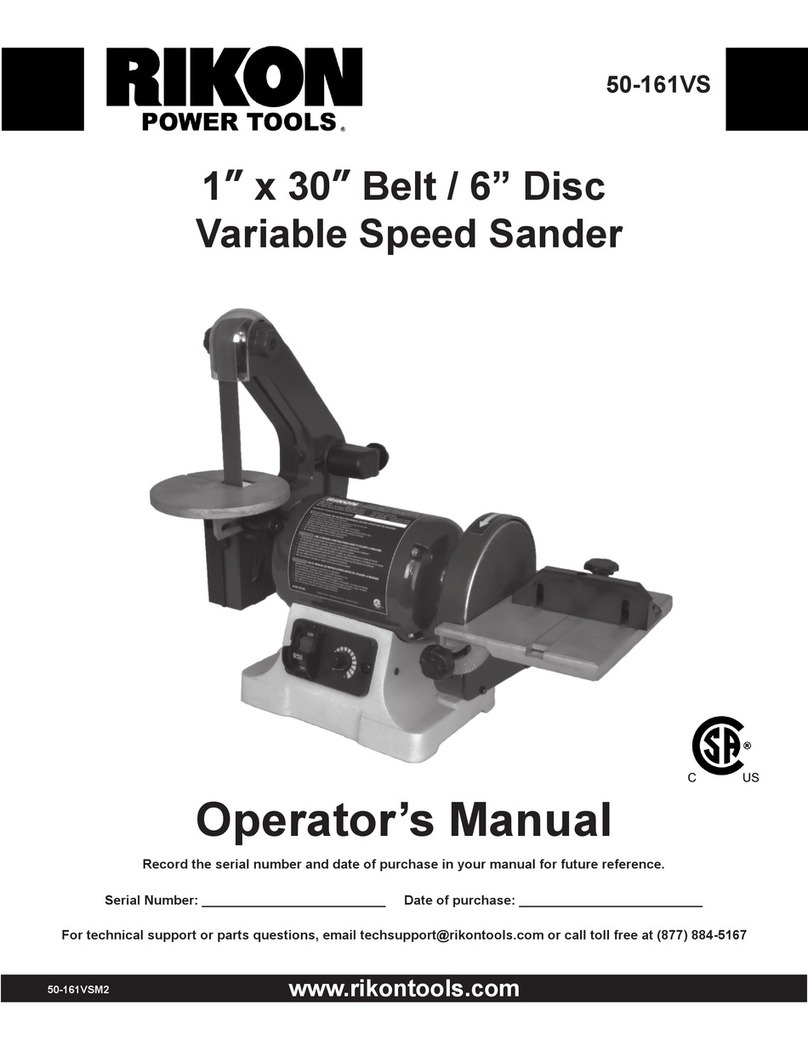
Rikon Power Tools
Rikon Power Tools 50-161VS User manual
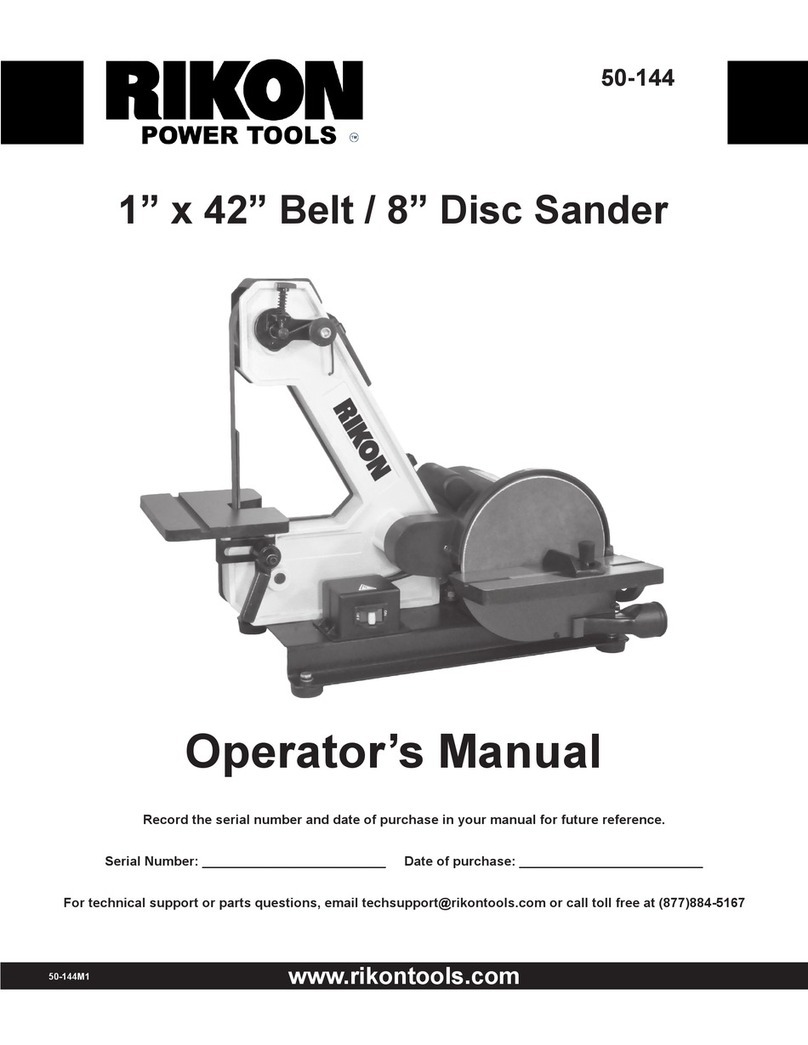
Rikon Power Tools
Rikon Power Tools 50-144 User manual
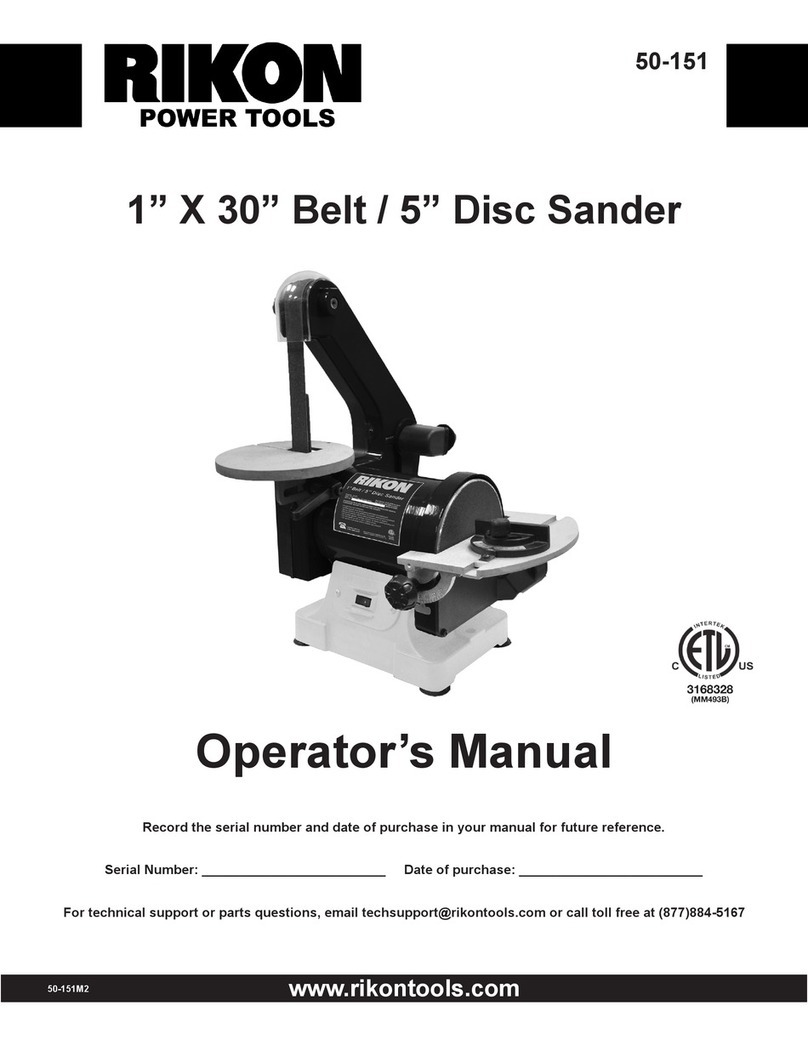
Rikon Power Tools
Rikon Power Tools 50-151 User manual
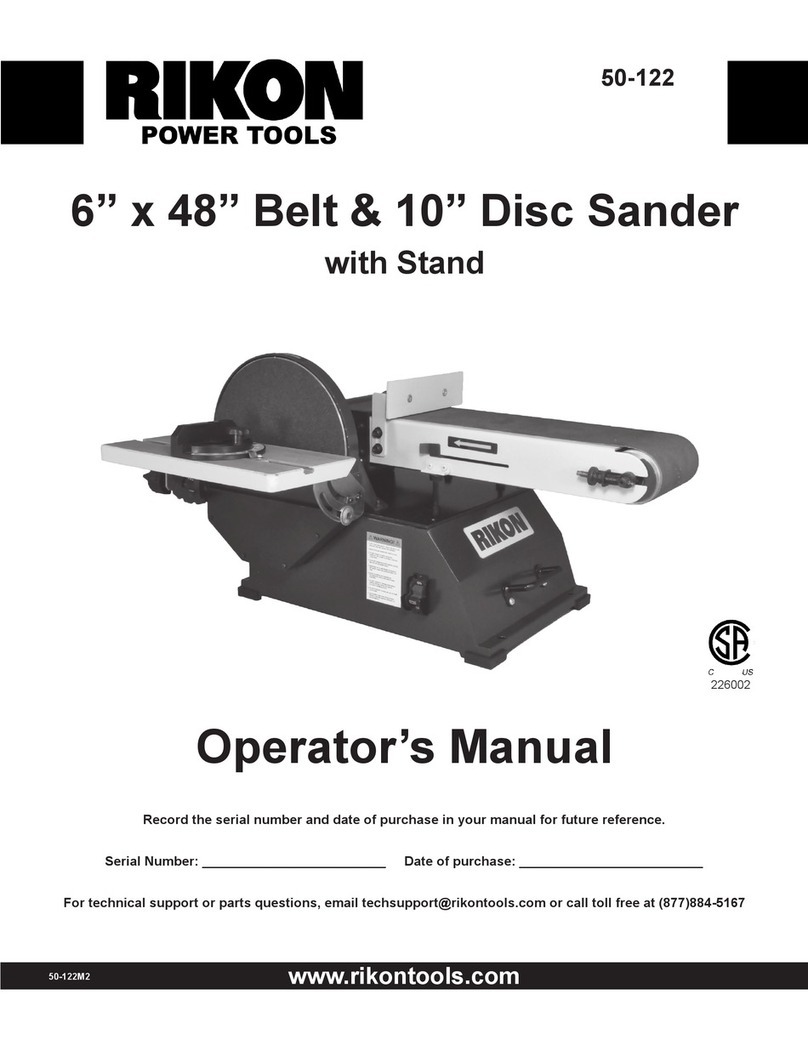
Rikon Power Tools
Rikon Power Tools 50-122 User manual
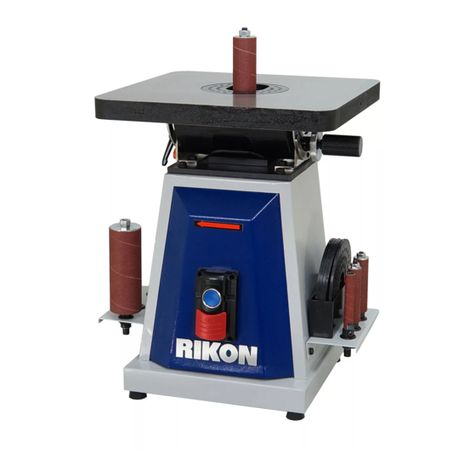
Rikon Power Tools
Rikon Power Tools 50-300 User manual
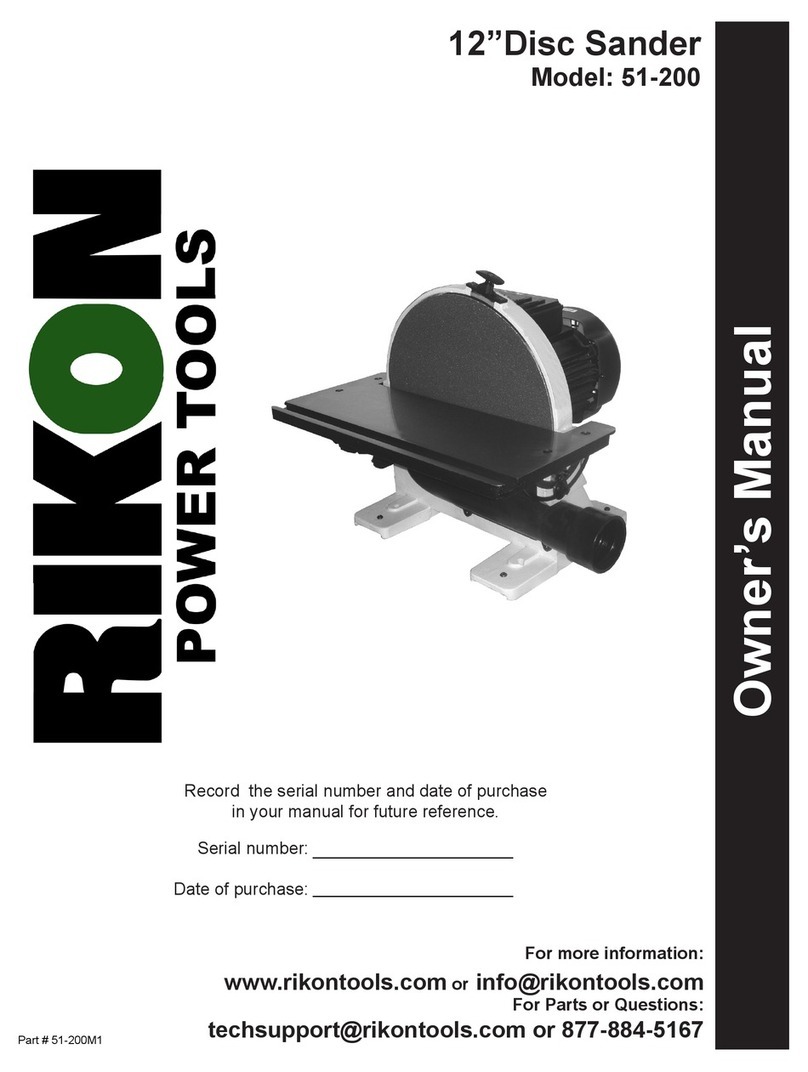
Rikon Power Tools
Rikon Power Tools 51200 User manual
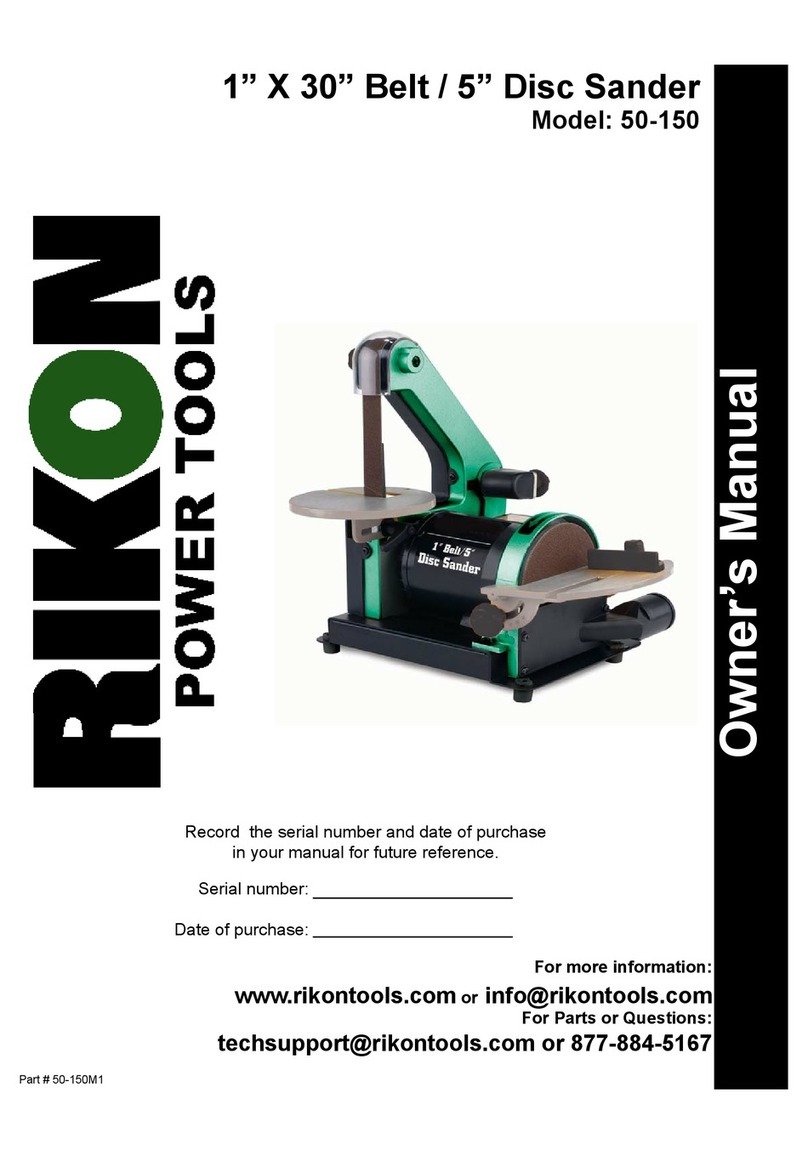
Rikon Power Tools
Rikon Power Tools 50-150 User manual
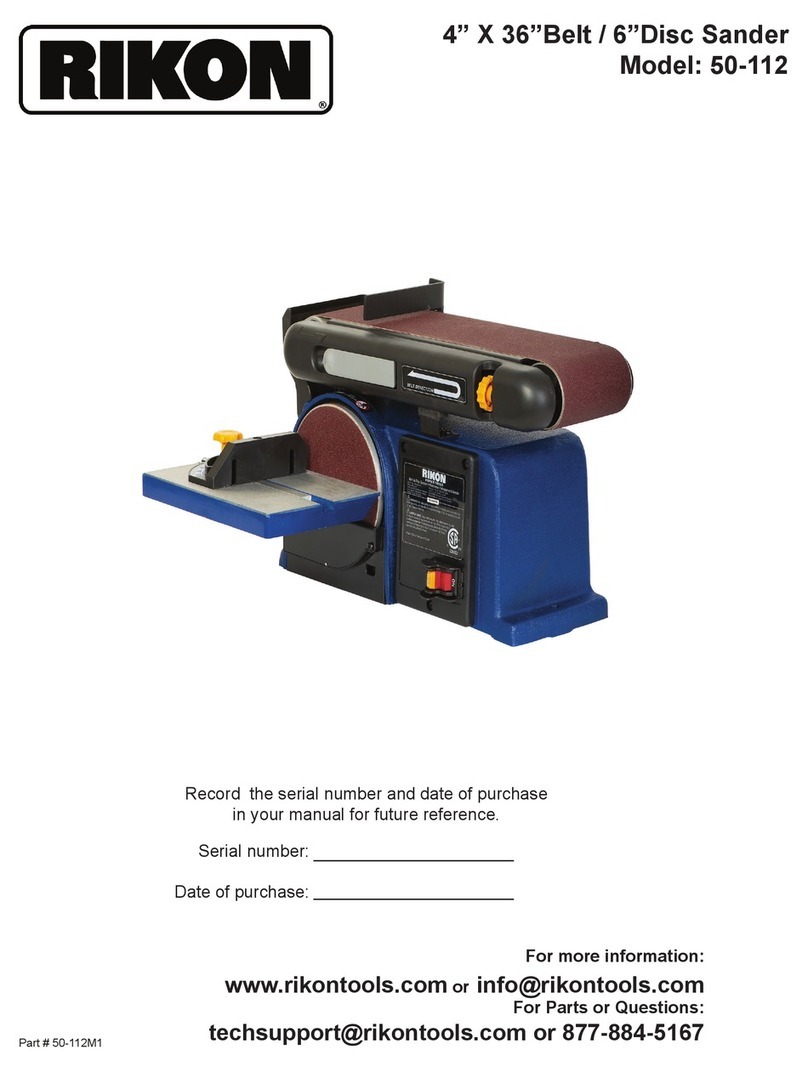
Rikon Power Tools
Rikon Power Tools 50-112 User manual

Rikon Power Tools
Rikon Power Tools 50-120 User manual
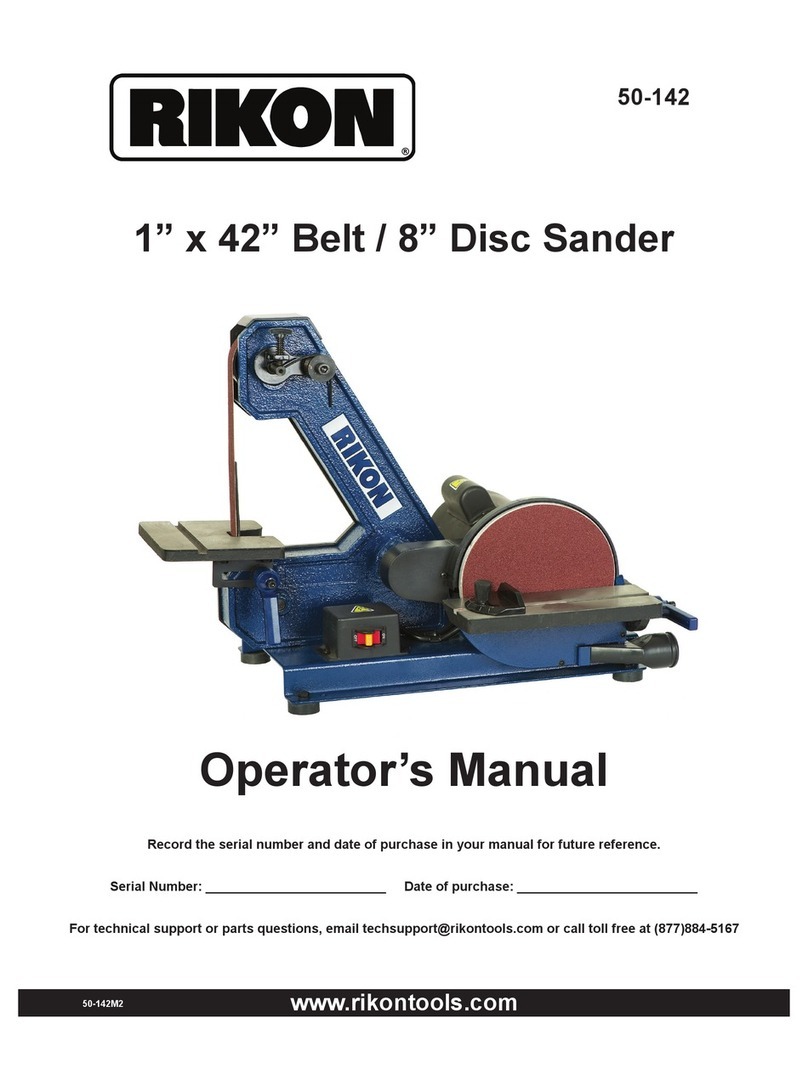
Rikon Power Tools
Rikon Power Tools 50-142 User manual
